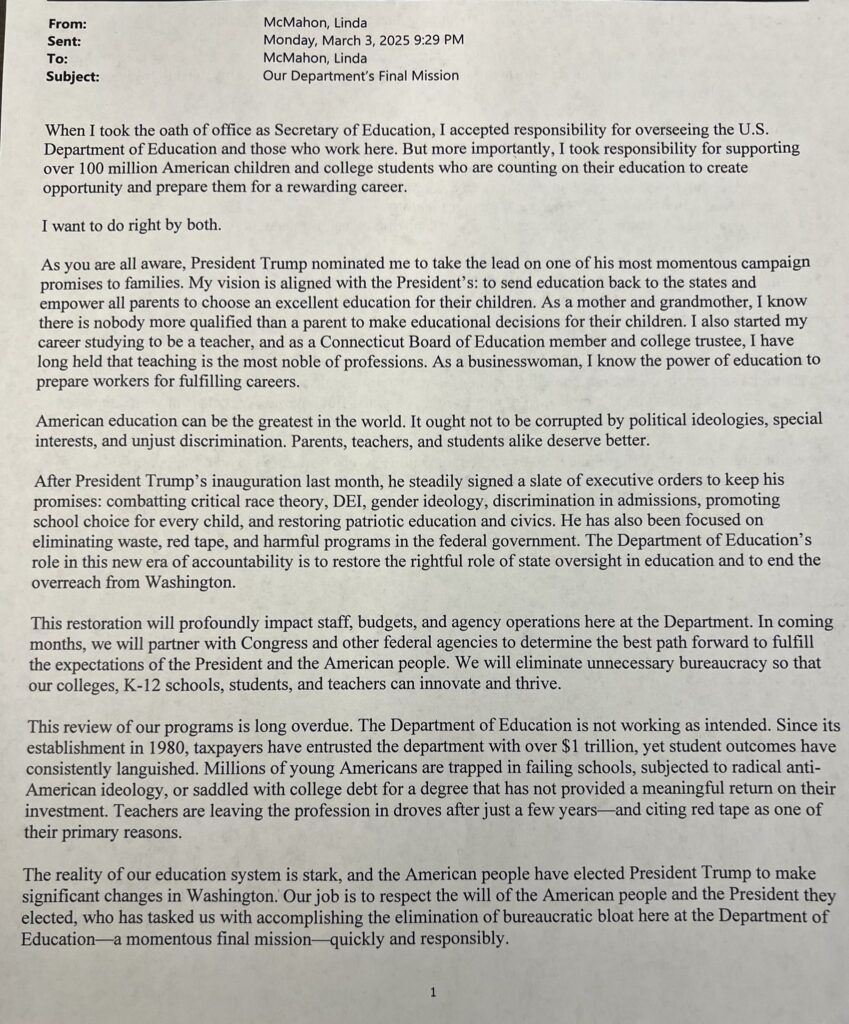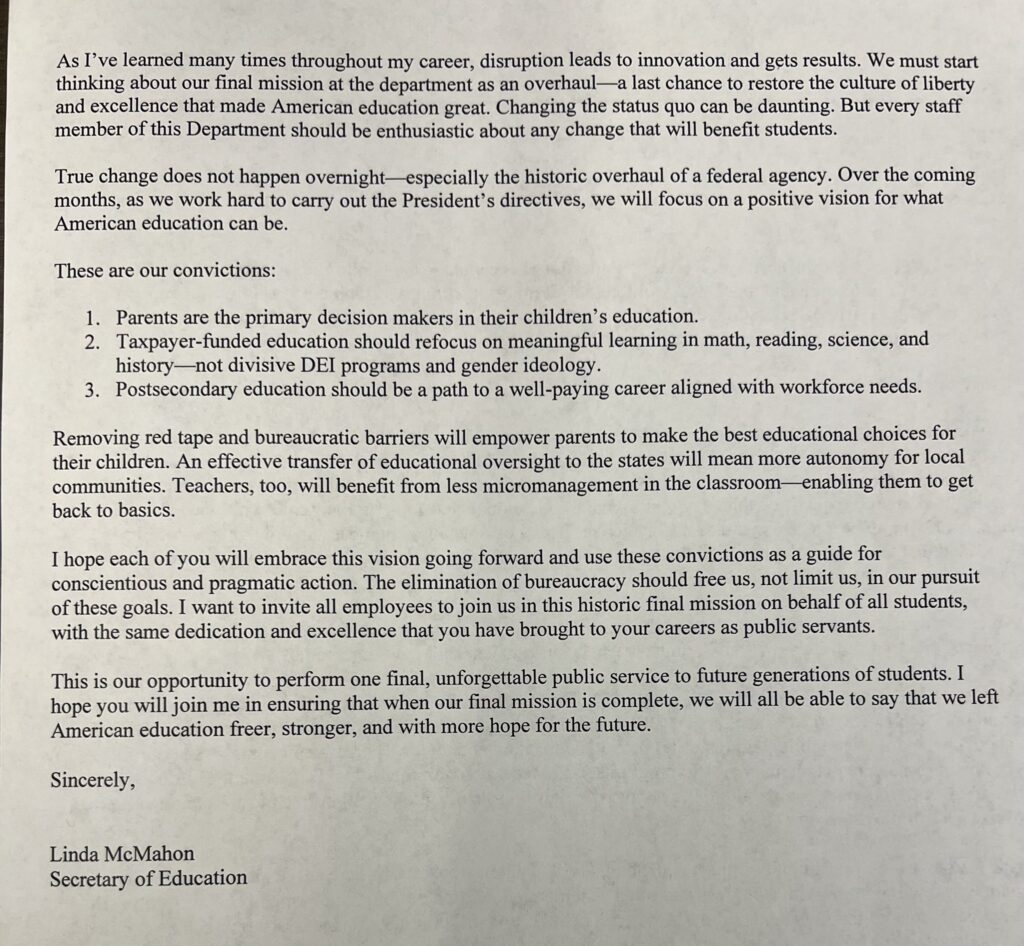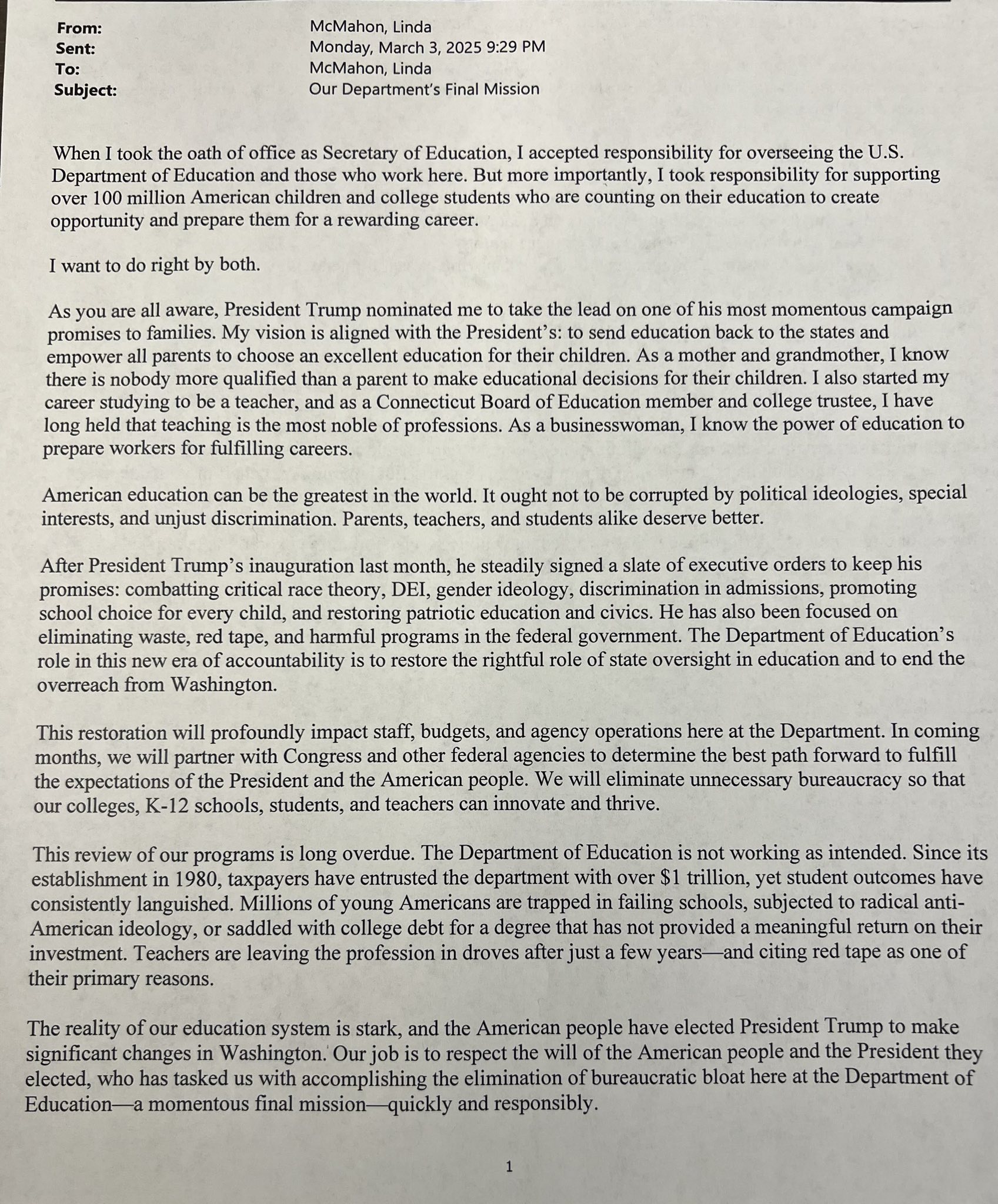From: McMahon, Linda
Sent: Monday, March 3, 2025 9:29 PM
Subject: Our Department’s Final Mission
When I took the oath of office as Secretary of Education, I accepted responsibility for overseeing the U.S. Department of Education and those who work here. But more importantly, I took responsibility for supporting over 100 million American children and college students who are counting on their education to create opportunity and prepare them for a rewarding career I want to do right by both.
As you are all aware, President Trump nominated me to take the lead on one of his most momentous campaign promises to families. My vision is aligned with the President’s: to send education back to the states and empower all parents to choose an excellent education for their children. As a mother and grandmother, I know there is nobody more qualified than a parent to make educational decisions for their children. I also started my career studying to be a teacher, and as a Connecticut Board of Education member and college trustee, I have long held that teaching is the most noble of professions. As a businesswoman, I know the power of education to prepare workers for fulfilling careers.
American education can be the greatest in the world. It ought not to be corrupted by political ideologies, special interests, and unjust discrimination. Parents, teachers, and students alike deserve better.
After President Trump’s inauguration last month, he steadily signed a slate of executive orders to keep his promises: combatting critical race theory, DEI, gender ideology, discrimination in admissions, promoting school choice for every child, and restoring patriotic education and civics. He has also been focused on eliminating waste, red tape, and harmful programs in the federal government. The Department of Education’s role in this new era of accountability is to restore the rightful role of state oversight in education and to end the overreach from Washington.
This restoration will profoundly impact staff, budgets, and agency operations here at the Department. In coming months, we will partner with Congress and other federal agencies to determine the best path forward to fulfill the expectations of the President and the American people. We will eliminate unnecessary bureaucracy so that our colleges, K-12 schools, students, and teachers can innovate and thrive.
This review of our programs is long overdue. The Department of Education is not working as intended. Since its establishment in 1980, taxpayers have entrusted the department with over $ 1 trillion, yet student outcomes have consistently languished. Millions of young Americans are trapped in failing schools, subjected to radical anti-American ideology, or saddled with college debt for a degree that has not provided a meaningful return on their investment. Teachers are leaving the profession in droves after just a few years- -and citing red tape as one of their primary reasons.
The reality of our education system is stark, and the American people have elected President Trump to make significant changes in Washington. Our job is to respect the will of the American people and the President they elected, who has tasked us with accomplishing the elimination of bureaucratic bloat here at the Department of Education -a momentous final mission- quickly and responsibly.
As I’ve learned many times throughout my career, disruption leads to innovation and gets results. We must start thinking about our final mission at the department as an overhaul-a last chance to restore the culture of liberty and excellence that made American education great. Changing the status quo can be daunting. But every staff member of this Department should be enthusiastic about any change that will benefit students.
True change does not happen overnight – especially the historic overhaul of a federal agency. Over the coming months, as we work hard to carry out the President’s directives, we will focus on a positive vision for what American education can be.
These are our convictions:
- Parents are the primary decision makers in their children’s education.
- Taxpayer-funded education should refocus on meaningful learning in math, reading, science, and history–not divisive DEI programs and gender ideology.
- Postsecondary education should be a path to a well-paying career aligned with workforce needs.
- Removing red tape and bureaucratic barriers will empower parents to make the best educational choices for their children. An effective transfer of educational oversight to the states will mean more autonomy for local communities. Teachers, too, will benefit from less micromanagement in the classroom- enabling them to get back to basics.
I hope each of you will embrace this vision going forward and use these convictions as a guide for conscientious and pragmatic action. The elimination of bureaucracy should free US, not limit us, in our pursuit of these goals.
I want to invite all employees to join us in this historic final mission on behalf of all students, with the same dedication and excellence that you have brought to your careers as public servants.
This is our opportunity to perform one final, unforgettable public service to future generations of students. I hope you will join me in ensuring that when our final mission is complete, we will all be able to say that we left American education freer, stronger, and with more hope for the future.
Sincerely,
Linda McMahon
Secretary of Education


ID: Printout of email from McMahon.






